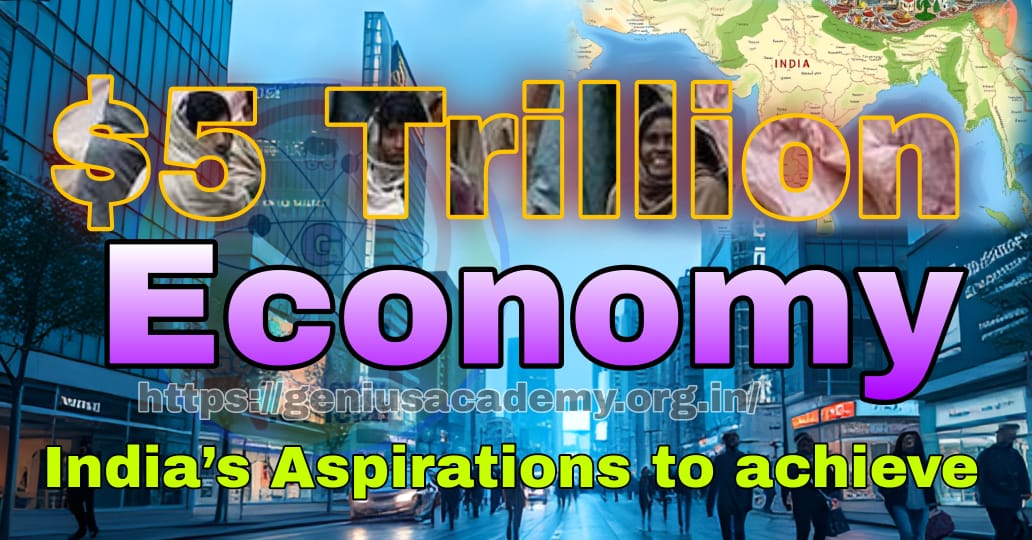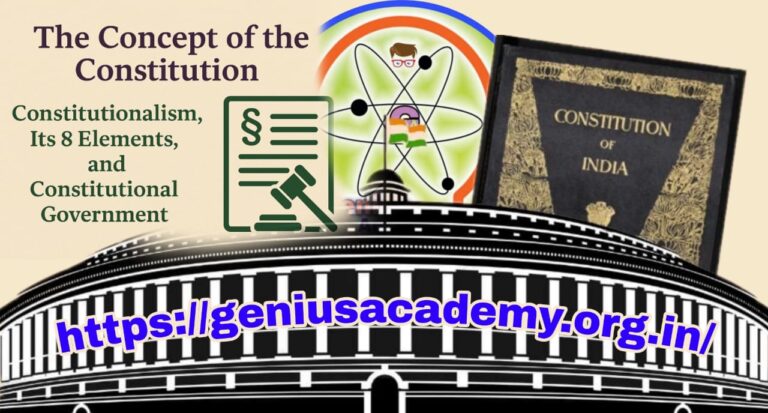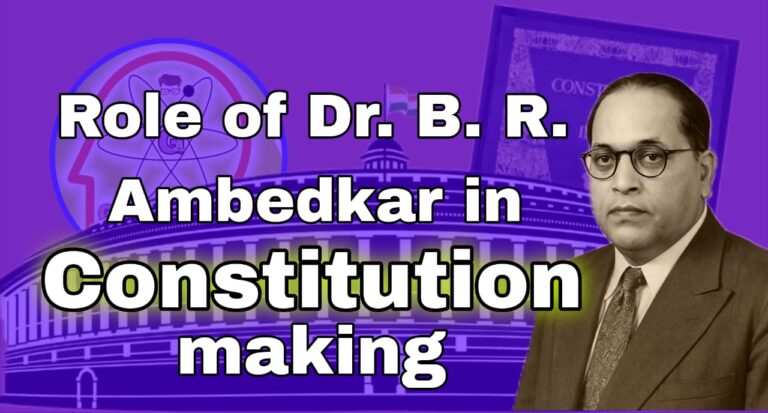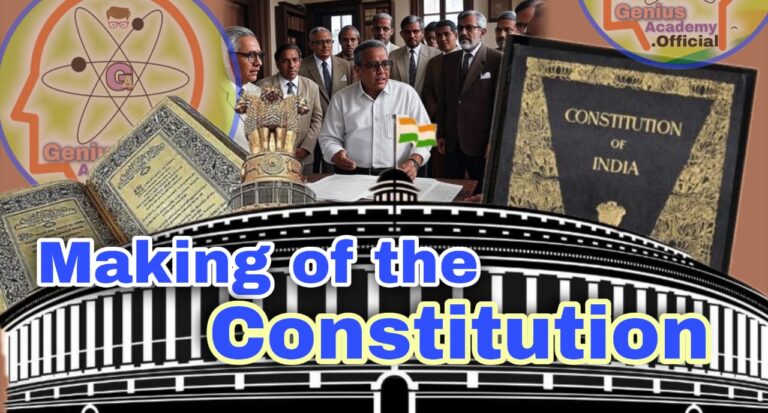India’s Aspiration to Achieve a $5 Trillion Economy: Opportunities and Challenges
India’s ambition to become a $5 trillion economy reflects its growing global influence and determination to uplift the standard of living for its citizens. This vision encapsulates efforts across multiple sectors to achieve sustainable, inclusive, and equitable growth. Below is a detailed exploration of the context, progress, challenges, and the way forward for India’s economic aspirations.
1. Context: Understanding India’s $5 Trillion Goal
India’s Economic Position
- Fifth Largest Economy: As of the Union Budget 2023-24, India is the fifth-largest economy globally, with a GDP of $3.5 trillion.
- Developing Nation: Despite significant growth, India remains classified as a developing country due to challenges like poverty, inequality, and infrastructure deficits.
- Fastest Growth Among Major Economies: The Economic Survey 2022-23 projected India’s GDP growth rate to range between 6% and 6.8% for FY24, making it one of the fastest-growing economies.
Global Economic Significance
- Remittances Leader: In 2022, India was the largest recipient of remittances, with $100 billion inflows.
- Foreign Exchange Reserves: India is the sixth-largest holder of foreign exchange reserves, enhancing its economic resilience.
2. India’s Achievements Toward a $5 Trillion Economy
2.1 Economic Growth
- Nominal GDP: India is the world’s fifth-largest economy in nominal terms and third-largest based on purchasing power parity (PPP).
- Diverse Growth Engines: Key contributors include agriculture, industry, services, and technology-driven sectors like IT.
2.2 Poverty Alleviation
- Reduction in Multidimensional Poverty: Between 2005-06 and 2019-21, multidimensional poverty fell significantly, reducing deprivation in health, education, and living standards.
2.3 Education and Literacy
- Improved Literacy Rates: Literacy rose from 18.33% in 1951 to 74.04% in 2011, reflecting substantial progress in educational access.
- Higher Education Expansion: India now hosts some of the largest education systems in the world, including institutions of global repute like IITs and IIMs.
2.4 Healthcare Advancements
- Life Expectancy: Life expectancy increased from 37 years in 1950 to about 70 years in 2023.
- Reduction in Infant Mortality: The infant mortality rate dropped from 146 in 1950 to approximately 27 in 2023, due to improved healthcare infrastructure.
2.5 Infrastructure Development
- Road Network: India has the second-largest road network in the world, facilitating trade and connectivity.
- Electrification: Over 99.2% of households had electricity access by 2023, signaling near-universal electrification.
2.6 Technological Advancements
- IT and Software Services: India’s IT industry contributes approximately 8% to GDP and remains a global leader in software development and services.
- Space Achievements: Milestones include the Mars Orbiter Mission (Mangalyaan), Chandrayaan lunar missions, and the Anti-SAT mission.
3. Challenges on the Path to a $5 Trillion Economy
3.1 Economic Inequality
- Wealth Concentration: According to Oxfam, the top 10% of Indians hold 77% of national wealth.
- Regressive GST Impact: About 64% of GST collections come from the bottom 50% of the population, while the top 10% contribute only 3%.
- Low Per Capita Income: India’s per capita income is $2,400, significantly below countries like China ($13,000) and Japan ($34,000).
3.2 Education
- Decline in Learning Outcomes: The Annual State of Education Report (ASER) 2022 showed a drop in basic reading comprehension to pre-2012 levels.
- Employability Gap: Only 49% of Indian youth are employable, according to the India Skill Report 2023.
3.3 Healthcare Deficits
- Doctor-Patient Ratio: India’s doctor-population ratio stands at 1:1,445, below the WHO’s recommended 1:1,000.
- Health Infrastructure: Rural healthcare facilities remain underdeveloped, with disparities in access to medical services.
3.4 Governance and Corruption
- Corruption Perception: India ranks 85th among 180 nations in Transparency International’s 2022 Corruption Perception Index, reflecting challenges in governance.
3.5 Gender Inequality
- Global Gender Gap: India ranks 135th out of 146 countries in the Global Gender Gap Report 2022, highlighting disparities in economic participation, education, and health.
3.6 Digital Divide
- Urban-Rural Gap: Only 31% of the rural population uses the internet compared to 67% in urban areas.
- Digital Literacy: Limited digital literacy in rural areas hinders the adoption of tech-driven solutions.
4. The Way Forward
4.1 Boosting Digital Infrastructure
- Broadband Access: Build a digital superhighway to expand broadband accessibility nationwide, particularly in rural areas.
- Digital Literacy Programs: Train rural populations in digital tools and technologies to bridge the digital divide.
4.2 Enhancing Export Competitiveness
- Policy Reforms: Simplify export procedures, provide tax incentives, and invest in upgrading trade infrastructure.
- Trade Agreements: Forge comprehensive bilateral and multilateral trade agreements to access new markets.
4.3 Strengthening Education and Skill Development
- Education Reforms: Enhance school curricula to focus on foundational skills and digital literacy.
- Vocational Training: Promote skill development programs aligned with industry requirements to boost employability.
4.4 Healthcare Improvements
- Public Health Investment: Increase budgetary allocation for public healthcare and expand the Ayushman Bharat program.
- Rural Healthcare Access: Build more primary health centers (PHCs) and recruit healthcare professionals for underserved areas.
4.5 Promoting Inclusive Growth
- Reducing Inequality: Implement progressive taxation and social welfare schemes to redistribute wealth.
- Gender Equality: Strengthen women’s participation in the workforce by ensuring equal pay and access to education.
4.6 Agrarian Transformation
- Precision Agriculture: Adopt data-driven farming techniques to optimize resource use and productivity.
- Climate-Resilient Farming: Promote crop diversification and sustainable practices to mitigate climate risks.
4.7 Governance Reforms
- Anti-Corruption Measures: Strengthen transparency in public procurement and implement stricter anti-corruption laws.
- Ease of Doing Business: Simplify regulatory processes to attract foreign and domestic investment.
Conclusion
Achieving a $5 trillion economy is not just about economic growth; it is about creating a sustainable, inclusive, and equitable society. India’s progress in sectors like IT, infrastructure, and poverty alleviation demonstrates its potential to achieve this goal. However, addressing challenges such as inequality, healthcare deficits, and governance issues is critical. A concerted effort involving policy reforms, investments in human capital, and international cooperation will be essential for India to realize its aspirations of becoming a global economic powerhouse.
Top 5 Largest Economies in the World 2024
India, the world’s fifth-largest economy by GDP, presents a paradox: while its overall economic indicators reflect significant growth, the condition of its common people often tells a different story. The gap between macroeconomic achievements and microeconomic realities highlights systemic issues of inequality, income disparity, and uneven development.
| Rank & Country | GDP (USD) | 2024 Projected Real GDP (% Change) | GDP Per Capita | Flag |
|---|---|---|---|---|
| #1 United States (U.S) | $29.17 trillion | 2.8% | $86.6 thousand | |
| #2 China | $18.27 trillion | 4.8% | $12.97 thousand |  |
| #3 Germany | $4.71 trillion | 0% | $55.52 thousand | |
| #4 Japan | $4.07 trillion | 0.3% | $32.86 thousand | |
| #5 India | $3.89 trillion | 7% | $2.7 thousand |
The Reality of India’s Economy
Economic Inequality in India
Why Per Capita Income Misleads
Causes of Worsening Economic Conditions
The Way Forward
Daily Mains Practice Questions
UPSC (CSE) Mains Questions on India’s Goal of $5 Trillion Economy
General Studies Paper II (Governance, Constitution, Polity, Social Justice, and International Relations)
[Q1.] Examine the role of governance reforms and anti-corruption measures in enabling India to achieve its goal of a $5 trillion economy. How can improved transparency enhance India’s business environment?
(250 words)
[Q2.] Discuss how inclusive policies addressing gender inequality and regional disparities can contribute to India’s ambition of becoming a $5 trillion economy. Illustrate with examples.
(250 words)
[Q3.] Critically analyze the role of international trade agreements and export competitiveness in India’s journey toward a $5 trillion economy.
(250 words)
[Q4.] Evaluate India’s achievements in reducing multidimensional poverty in light of its economic aspirations. How can these gains be sustained?
(250 words)
General Studies Paper III (Economic Development, Agriculture, Environment, Science & Technology)
[Q5.] India’s IT sector contributes significantly to GDP. Discuss the challenges and opportunities for further leveraging technology to achieve a $5 trillion economy.
(250 words)
[Q6.] Analyze the impact of rural-urban digital divide on India’s economic growth. Suggest measures to bridge this gap to foster inclusive development.
(250 words)
[Q7.] What role does agrarian transformation, including precision agriculture and climate-resilient practices, play in achieving India’s $5 trillion economy goal? Discuss.
(250 words)
[Q8.] Critically assess the role of infrastructure development, such as road networks and electrification, in achieving sustained economic growth in India.
(250 words)
[Q9.] India’s health sector remains underdeveloped despite advancements. Discuss the importance of healthcare investment in achieving a $5 trillion economy.
(250 words)
[Q10.] Examine the potential of skill development and education reforms in boosting India’s workforce productivity to achieve its economic ambitions.
(250 words)
General Studies Paper IV (Ethics, Integrity, and Aptitude)
[Q11.] Corruption remains a barrier to India’s economic aspirations. Discuss the ethical challenges in governance that hinder economic development. Propose strategies to foster transparency and accountability.
(250 words)
FAQs on India’s $5 Trillion Economy Aspiration
1. Why does India aim to become a $5 trillion economy?
Answer:—
India’s aspiration to become a $5 trillion economy reflects its commitment to improving living standards, reducing poverty, creating jobs, and enhancing its global influence. It also aligns with its goal of achieving sustainable and inclusive growth while addressing developmental challenges.
2. How close is India to achieving this target?
Answer:—
As of 2023-24, India’s GDP is approximately $3.5 trillion, making it the fifth-largest economy globally. With a growth rate of 6-6.8%, India is on track, but it requires significant policy and structural reforms to achieve the $5 trillion mark by the target year.
3. What are the main challenges in achieving this goal?
Answer:—
Key challenges include:
- Poor healthcare infrastructure and low doctor-population ratio.
- Digital divide between urban and rural areas.
- Declining educational outcomes and low youth employability.
- Corruption and bureaucratic inefficiencies.
4. What role does technology play in this goal?
Answer:—
Technology, particularly through Digital India and IT sector contributions, is pivotal. It can enhance productivity, improve governance, and create new economic opportunities. Bridging the digital divide is essential for ensuring equitable growth.
5. How can healthcare reforms contribute to this goal?
Answer:—
Improved healthcare infrastructure ensures a healthier workforce, reduces economic losses due to illnesses, and enhances overall productivity. Investment in rural healthcare and achieving the WHO-recommended doctor-patient ratio are critical.
6. What steps can be taken to reduce economic inequality?
Answer:—
Measures include:
- Progressive taxation to reduce wealth concentration.
- Social welfare programs targeting vulnerable populations.
- Empowering women and marginalized communities through education and employment opportunities.
7. How does the global economic environment impact India’s ambitions?
Answer:—
Global challenges like inflation, geopolitical tensions, and trade barriers can slow India’s progress. Strengthening international trade agreements and reducing dependency on imports can mitigate external risks.
8. What is the significance of the digital superhighway in India’s economic journey?
Answer:—
A digital superhighway would improve broadband access, foster digital literacy, and drive innovation in e-commerce, telemedicine, and education, particularly in rural areas. This is crucial for bridging urban-rural divides and boosting overall economic productivity.
9. What role do exports play in achieving the $5 trillion goal?
Answer:—
Exports are vital for foreign exchange earnings and economic growth. Enhancing export competitiveness through policy incentives, improved trade infrastructure, and bilateral agreements can help India penetrate global markets effectively.
10. Why is gender equality essential for achieving this goal?
Answer:—
Gender equality can unlock the potential of half the population, increasing workforce participation, boosting productivity, and fostering inclusive growth. Addressing disparities in education, pay, and healthcare access is critical for achieving the $5 trillion economy
By addressing these questions and focusing on policy-driven reforms, India can effectively navigate challenges and achieve its vision of becoming a $5 trillion economy.





